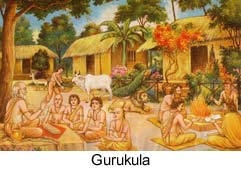

 |  |
 The life of a man in the Aryan society was divided into four stages of 25 years each, assuming that a man lived for 100 years. The first part of his life span, that is from birth till the age of 25 years was supposed to be the period of Brahmacharya (celibacy). During this period he was supposed to be busy in studies.
The life of a man in the Aryan society was divided into four stages of 25 years each, assuming that a man lived for 100 years. The first part of his life span, that is from birth till the age of 25 years was supposed to be the period of Brahmacharya (celibacy). During this period he was supposed to be busy in studies.The Vedic Aryans did not know the art of writing. However, they possessed a literature handed down in a particular school by word of mouth. Therefore, the Aryans sent their sons to the house of the teacher where they lived as members of his family. The word gurukula means the family of the teacher. The young people lived with the Guru till he learnt enough to lead a decent life. The Gurukula was situated in a secluded area far away from the cities. The Guru was also a religious teacher under whom a pupil lived in complete obedience. Beside learning, the pupil helped the Guru's family in gathering wood or tending animals. There was no distinction of high or low caste in a Gurukul all lived like brothers and shared the same food. Education was free but students from well-to-do families payed Gurudakshina, a sought of voluntary contribution after the completion of their studies. At the Gurukulas, the teacher imparted knowledge not only of religion, but also in arts of warfare, statecraft, medicine and astrology. Sometimes the Gurukulas were very large institutions and the name of the Guru attracted many students. Ashramas The term ashrama means a stage in the long journey of life of a man. Bhramacharya was a first stage of life from birth to twenty five years of age. And in this period he acquired knowledge by leading the life of a student. After the education in the Gurukula, the man entered the second stage of his life that is Grihastha ashrama (householders life) till the age of fifty. During this stage a man was supposed to marry and lead a family life following a set of customs & traditions. After this he entered vanaprastha ashrama (life of service to others) till the age of seventy five. During this third period he was supposed to break the family ties and serve the community. This stage was followed by Sanyasa (a renounced life in the forest) where a person had to abandon his complete social life and devote all his time in the service of God to attain salvation. next page >> |
Copyright ©2000 indiansaga.info. All rights reserved.
By using this service, you accept that you won't copy or use the data given in this website for any commercial purpose.
The material on indiansaga.info is for informational & educational purpose only.
This site is best viewed at 800 X 600 picture resolution.